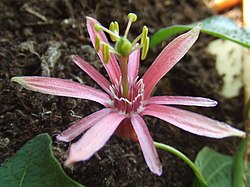| Passiflora sanguinolenta | |
|---|---|
 | |
| Passiflora sanguinolenta flower | |
| Scientific classification | |
| Kingdom: | Plantae |
| Clade: | Tracheophytes |
| Clade: | Angiosperms |
| Clade: | Eudicots |
| Clade: | Rosids |
| Order: | Malpighiales |
| Family: | Passifloraceae |
| Genus: | Passiflora |
| Species: | P. sanguinolenta |
| Binomial name | |
| Passiflora sanguinolenta | |
| Synonyms [1] | |
| |
Passiflora sanguinolenta is a flowering plant in the family Passifloraceae . [1] [2] It is sometimes referred to by the common name blood red passion flower and is native to Ecuador and Peru.
Wikimedia Commons has media related to Passiflora sanguinolenta .